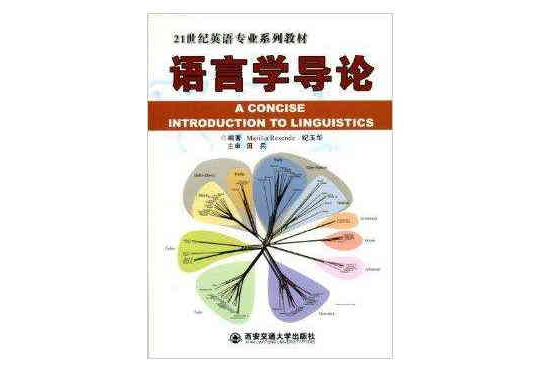基本介紹
- 書名:21世紀英語專業系列教材:語言學導論
- 作者:Marilia Resende
- 出版日期:2012年11月28日
- 語種:簡體中文
- ISBN:9787560545813, 7560545815
- 外文名:A Concise Introduction to Linguistics
- 出版社:西安交通大學出版社
- 頁數:188頁
- 開本:16
- 品牌:西安交通大學出版社
基本介紹
內容簡介
The book will contain 8 chapters and each chapter will deal with a different topic.Besides, each chapter includes learning objectives, an explanatory chart with the basic key concepts, a pretask to allow for warmup discussion, a comprehensive text to cover the key concepts relevant to the topic, and many followup tasks, which help students acquire a practical outlook of the course and involve either pair work or group work.In addition, there is a chapter summary for students to review, a checklist for selfassessment purposes, and a few critical thinking exercises to develop students' problemsolving skills.The idea is to make Linguistics an appealing and engaging subject for students but also to allow the teacher some flexibility to select the exercises he / she wishes to cover in every chapter as well as the tasks he / she finds more suitable for the targetgroup.
作者簡介
圖書目錄
PREFACE
CHAPTER 1 LANGUAGE AND LINGUISTICS /1
WHAT IS THE RELATIONSHIP BETWEEN LANGUAGE AND LINGUISTICS?/2
1.Linguistics as a Science/2
2.Language and Linguistics/3
3.Origins and Functions of Language/5
4.Spoken and Written Language/8
5.Langue and Parole, Competence and Performance/10
6.Linguistics as a Field of Research/12
7.Different Approaches to Linguistics/13
8.Major Schools of Linguistics/14
CHAPTER 2 PHONETICS AND PHONOLOGY/20
WHAT ARE SPEECH SOUNDS? /21
1.Sounds and Letters/21
2.Production of Sounds/24
3.Classification of Sounds/26
4.Transcription of Sounds/31
5.Phonetics: Phones and Allophones/33
6.Phonology: Phonemes/34
7.Phonological Rules/36
8.Prosody: Intonation and Stress/38
CHAPTER 3 MORPHOLOGY/44
WHAT ARE WORDS? /45
1.Words and Word Classes/45
2.Morphs, Allomorphs and Morphemes/48
3.Types of Morphemes/49
4.Inflectional and Derivational Morphology/50
5.Word Formation Processes/53
CHAPTER 4 SYNTAX/65
WHAT IS GRAMMAR? /67
1.Grammar: Prescriptive and Descriptive/67
2.Grammaticality, Acceptability and Syntactic Ambiguity/68
3.Syntactic Structures/71
4.Syntactic Categories/74
5.Syntactic Functions/76
6.Types of Sentences/78
7.Types of Clauses/81
CHAPTER 5 SEMANTICS /86
WHAT IS MEANING? /87
1.Meaning, Sense and Reference/87
2.Levels of Meaning: Lexical and Sentential/89
3.Componential Analysis/93
4.Synonymy, Antonymy, Homonymy and Hyponymy/94
5.Entailment, Presupposition, Inconsistency, Contradiction, Tautology and Anomaly / 100
6.Metaphorical Usage/101
7.Idiomatic Usage/104
CHAPTER 6 PRAGMATICS /109
WHAT IS LANGUAGE USE? /110
1.Semantics versus Pragmatics/110
2.Reference and Inference/113
3.Cohesion and Coherence/115
4.Locutionary, Illocutionary and Perlocutionary Acts /117
5.The Cooperative Principle/119
6.Conversational Implicature/120
7.The Politeness Principle /122
8.Concept of 'Face' /124
CHAPTER 7 LANGUAGE VARIATION /130
WHAT IS LANGUAGE VARIATION? /131
1.Sociolinguistics Language and Society /131
2.Accents and Dialects /132
3.Sociolects or Social Dialects /137
4.Register and Jargon/141
5.Jargon, Slang and Argot/143
6.Slang,Taboo and Euphemisms/144
7.Language and Culture/146
CHAPTER 8 LANGUAGE CHANGE/153
WHAT IS LANGUAGE CHANGE? /154
1.Language and History/154
2.Internal Causes of Language Change/156
3.External Causes of Language Change/158
4.History of English/161
5.Changes in Pronunciation and Spelling/167
6.Changes in Grammar/168
7.Changes in Vocabulary/169
8.Changes in Meaning/171
APPENDIX 1: KEY TO EXERCISES /178
APPENDIX 2.BIBLIOGRAPHY 187

